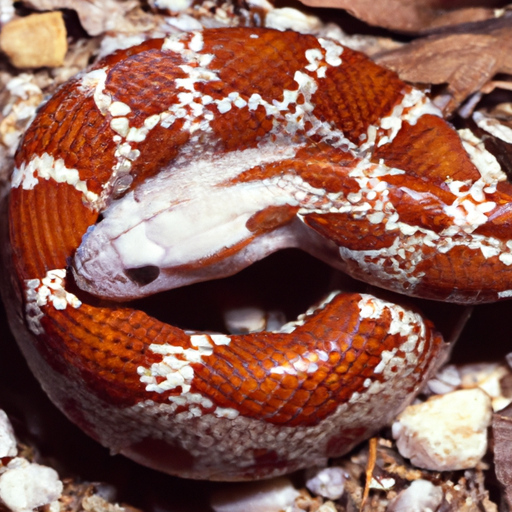So you’re curious about corn snakes, huh? Specifically, you want to know if these slithery creatures can lay eggs without even going through the whole mating process.
Well, you’ve come to the right place! In this article, we’ll explore the fascinating world of corn snakes and uncover whether or not they have the ability to lay eggs without mating.
Get ready to uncover the truth behind this intriguing question!

Introduction
Corn snakes, scientifically known as Pantherophis guttatus, are popular reptile pets known for their vibrant colors and docile nature.
As owners, it’s essential to have a good understanding of their reproductive process, as this knowledge can provide valuable insights into their behavior and well-being.
One intriguing aspect of corn snake reproduction is the possibility of asexual reproduction, where females can lay eggs without the need for mating.
In this article, we will explore the fascinating world of corn snake reproduction, including both sexual and asexual processes, the factors influencing asexual reproduction, the frequency of its occurrence, and the benefits and limitations it brings.
By the end, you will have a comprehensive understanding of how corn snakes reproduce and the implications it has for their conservation and breeding programs.
Reproduction in Corn Snakes
Background
Before delving into the intricacies of corn snake reproduction, it’s essential to understand the basic physiology and anatomy of these reptiles.
Corn snakes, native to North America, typically reach maturity around three to four years of age.
They have internal fertilization, meaning that mating occurs when the male transfers his sperm to the female’s reproductive tract.
The fertilization then takes place internally with the joining of the male’s sperm and the female’s eggs.
Mating Behavior
During the mating season, male corn snakes display distinctive behaviors to attract females.
They release pheromones, which are chemical signals that convey their presence and availability to potential mates.
These pheromones can be detected by receptive females, who will respond by displaying receptive behaviors such as raising their tails and adopting a passive stance.
Once courtship is initiated, the male corn snake will approach the female and align their bodies to allow for successful copulation.
Mating can last anywhere from a few minutes to several hours, during which the male transfers his sperm to the female through the use of specialized structures called hemipenes.
Egg Development
Following successful mating, the female corn snake’s reproductive system undergoes a series of changes to support egg development.
After a gestation period of roughly three to four weeks, the female will begin ovulating, which involves the release of fully developed eggs from her ovaries into her oviduct.
During this stage, the eggs are fertilized by the sperm stored in the female’s reproductive tract from previous matings.
The eggs then travel through the oviduct where they receive additional layers of protective covering, including a semi-permeable membrane and a leathery shell.
Incubation
Once the eggs are laid, whether through sexual or asexual reproduction, they require specific conditions for successful incubation.
Corn snake eggs are typically laid in a secluded location, such as a nesting box or cavity, where the female can provide a suitable environment for their development.
Incubation temperature plays a crucial role in determining the sex of the hatchlings.
Higher temperatures during incubation tend to result in more male hatchlings, while lower temperatures favor the development of females.
The incubation period lasts approximately eight to twelve weeks, after which the hatchlings emerge from their eggs.
Asexual Reproduction
Parthenogenesis
One remarkable aspect of corn snake reproduction is the ability of females to reproduce asexually through a process called parthenogenesis.
Parthenogenesis involves the development of viable embryos without the need for fertilization by a male.
In this process, the female’s eggs undergo the necessary transformations and embryo development as if they had been fertilized by sperm.
Parthenogenesis can occur naturally or be induced artificially in captive settings. It is believed to be an evolutionary adaptation that allows some females to reproduce even when males are scarce or absent in the environment.
Female-only Clutches
In addition to parthenogenesis, female corn snakes can also produce female-only clutches.
In these instances, the eggs are laid without prior mating and develop into viable offspring that are genetically identical to the mother.
Female-only clutches are rare but have been observed and documented, both in the wild and in captive breeding environments.
This unique reproductive behavior provides an additional mechanism for female corn snakes to pass on their genetic material and contribute to the overall population, even in situations where male availability is limited.
Factors Influencing Asexual Reproduction
Environmental Conditions
The occurrence of asexual reproduction in corn snakes can be influenced by various environmental factors. One crucial factor is the presence or absence of males in the population.
When male corn snakes are scarce, females may exhibit a higher propensity for asexual reproduction as a means of continuing their genetic lineage.
The availability of suitable nesting sites and optimal incubation conditions also play a role.
If the environment provides ample resources and conditions for successful egg development and hatchling survival, the frequency of asexual reproduction may increase.
Genetic Factors
Genetic factors may also contribute to the likelihood of asexual reproduction in corn snakes.
Some researchers believe that certain genetic variations or combinations may make females more predisposed to asexual reproduction.
Further studies are necessary to unravel the intricate interplay between genetics and asexual reproduction in corn snakes fully.
Frequency of Asexual Reproduction
Natural Occurrence
In the wild, asexual reproduction in corn snakes is relatively rare compared to sexual reproduction. While instances of parthenogenesis have been observed, they are estimated to occur in less than 1% of the overall population.
However, the precise frequency of asexual reproduction in the wild remains a topic of ongoing research and investigation.
5.2 Captive Breeding
Captive breeding programs provide controlled environments where the occurrence of asexual reproduction can be more easily monitored and documented.
In captivity, the frequency of asexual reproduction tends to be higher due to several factors, including the absence of male snakes, hormonal cues, and the potential influence of artificial selection.
Captive breeding not only allows for the observation of asexual reproduction but also provides valuable data for studying the genetic and environmental factors that contribute to this phenomenon.
Benefits and Limitations of Asexual Reproduction
Reproductive Efficiency
One significant benefit of asexual reproduction in corn snakes is the potential for increased reproductive efficiency.
Females capable of asexual reproduction can produce offspring without the need for mating, allowing for more rapid population growth in certain situations.
This adaptability can be advantageous when resources are limited, or the population is small and needs a boost.
Genetic Diversity
While asexual reproduction provides a means for females to reproduce independently, it comes at a cost – a lack of genetic diversity.
Offspring produced through asexual reproduction are genetically identical to the mother, leading to reduced genetic variability within the population.
This reduced genetic diversity can impact the population’s ability to adapt to changing environmental conditions and increase susceptibility to diseases or other threats.
Adaptability
Asexual reproduction allows female corn snakes to adapt and reproduce even in the absence of available males or in an environment where mating opportunities are limited.
This adaptability can be particularly beneficial in situations where reproduction might otherwise be challenging or impossible due to factors such as geographic isolation, habitat disturbances, or declining population numbers.
Health Risks
While asexual reproduction offers certain advantages, it also poses potential health risks. The lack of genetic diversity resulting from asexual reproduction increases the chances of offspring inheriting harmful genetic mutations or predispositions to certain diseases.
These risks can have long-term implications for the overall health and survival of the population.
Comparing Asexual and Sexual Reproduction
Evolutionary Considerations
Both asexual and sexual reproduction have evolved as strategies for species survival. Sexual reproduction allows for genetic recombination and the creation of unique offspring, fostering genetic diversity and adaptability.
On the other hand, asexual reproduction can enhance reproductive efficiency and ensure the continuation of a genetic lineage even in challenging circumstances.
Species Preservation
In terms of species preservation, the occurrence of asexual reproduction, especially when natural populations are small or threatened, can be advantageous.
It provides an additional mechanism for reproduction and genetic legacy, potentially bolstering the overall survival of the species.
Breeding Programs
Breeding programs aimed at conserving and managing corn snake populations must carefully consider the balance between asexual and sexual reproduction.
While asexual reproduction may offer immediate benefits in terms of increasing numbers, maintaining genetic diversity through selective breeding and reintroduction of sexually produced offspring is essential for long-term population health and resilience.
Final Thoughts
Corn snakes, with their fascinating ability to reproduce both sexually and asexually, provide an exciting window into the world of reptile reproduction.
The occurrence of asexual reproduction in corn snakes, though relatively rare in the wild, holds essential implications for their conservation and captive breeding programs.
Understanding the factors influencing asexual reproduction, the benefits it brings in terms of reproductive efficiency and adaptability, as well as the limitations it poses regarding genetic diversity and health risks, is crucial for the responsible management of corn snake populations.
By deepening our knowledge of corn snake reproduction and appreciating the complexities and nuances it presents, we can ensure the well-being and long-term survival of these captivating creatures in both natural habitats and captivity.
So next time you observe your corn snake in its enclosure, you can appreciate the intricate and diverse ways they contribute to their species’ continuation and the beauty they bring to the world of reptiles.




